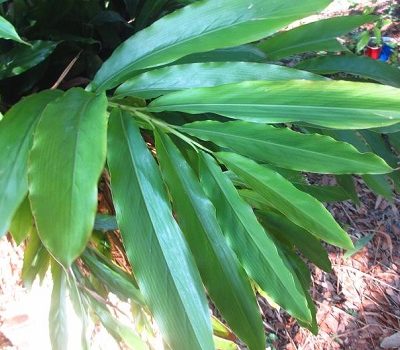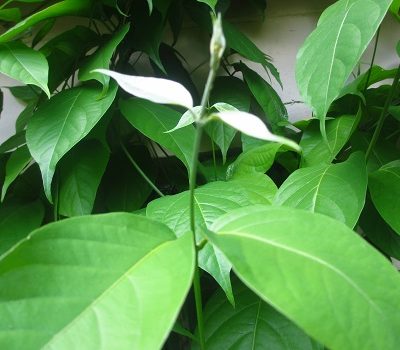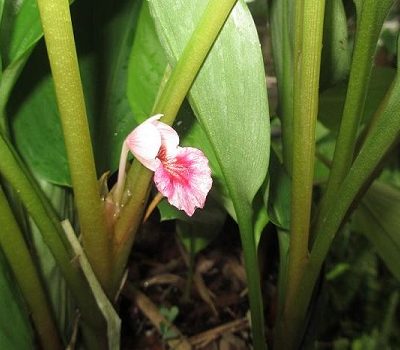From New Guinea and coastal Australia, this is the most common staghorn fern, but there are many regional variants within the species. An avid collector could easily overfill their yard with the many varieties of this species alone.
P. bifurcatum is without question, the best species of staghorn fern for the novice. They have all of the exotic beauty and strangeness of form exhibited in the genus, but they are also extremely easy to grow. I have several specimens permanently mounted on my oak trees, and I rarely have to lift a finger to do anything for them. Many people bring their staghorns in when the mercury begins to drop a little, but these plants can take very cold temperatures without any deleterious effects, as long as frost doesn’t form on the foliage. Here in zone 9b, Winter never gets cold enough to harm them. Since they have protection from the oak canopy, they never get frost on them, even when the temperature drops below 20F.
Australian species such as Platycerium bifurcatum tend to prefer to dry out a bit between watering. When a specimen is small, it will need more frequent watering. Once they get a bit larger it is best to be a bit more stingy with the water. I rarely ever water them once they establish themselves on the tree. All staghorn fern species have sterile fronds, sometimes called shield fronds that shelter their roots from desiccation. Those sterile fronds also collect falling debris which composts itself in the space between the frond and the tree. This composted organic material absorbs water during rains, which the plant uses when rain becomes scarce. When you grow them epiphytically on a tree, the way they do in nature, they require very little care.
Of course, not everyone lives in a climate suitable for leaving these plants outdoors all year long. Most people grow them in hanging baskets. They eventually cover the outside of the basket with sterile fronds, and the fertile fronds hang elegantly. These can then be brought to safety during harsh Winter conditions.
Another way they are commonly grown is on wooden plaques. In this way, they grow very similarly to how they’d grow in nature. These can be brought in a and hung on a wall like a picture. I used to use this method, but I got tired of the wood rotting and the fern dropping off on top the ground. The plant would inevitably be damaged by this, and also need to be re-mounted on a new piece of wood. Necessity being the mother of invention, I came up with a better version of this method. I use metal bakers racks, for small specimens, and barbecue grills for the larger ones. They cover the metal racks with their sterile fronds in a very short time, and they never rot off of their mount. The only disadvantage I’ve found is that they make the plant a little bit heavier.
Whichever method you use to grow them, the hardest part about Wintering them indoors will be providing enough humidity in the dry heated indoor air. They should only be kept indoors as long as necessary. Staghorn ferns do not make good houseplants. Try to provide them with a microclimate of higher humidity. Surrounding them with other plants will help. A friend of mine brings them into his bathroom, which has a skylight. the steam from showers, provides just enough humidity to get them through the Winter.
Binomial nomenclature
Platycerium bifurcatum
Origin
Australia, and New Guinea
Description
P. bifurcatum is the quintessential staghorn fern. They really do look like a pair of mounted deer antlers. This species “pups” freely. Growing new plants around the edges of the semi-circular sterile fronds. The sterile fronds of the new pups overlap with those of the older growths, creating a continuous layer of these fronds over the base of the plant. The fertile fronds grow outward from the base, and split or furcate, multiple times along their length. The result is a very antler looking frond, which is, of course, where the plant’s common name comes from. Spore patches will form on the underside of the the tips of the fertile fronds once the plant reaches maturity.
Size
There are a great number of cultivars of this species, with much variation between them, but the fertile fronds are usually greater than 20″, and less than 36″ in length. The clusters of plants can reach staggering sizes over time. I have seen old specimens that are larger than a VW beetle.
Temp/zone
P. bifurcatum prefers temperatures to be above 550:F. It will survive short periods of very cold temperatures. Damage will only occur when the plant begins to freeze. If provided shelter they can be grown outside down to zone 8.
Light
Bright filtered shade.
Water
Water regularly, but allow it to dry between watering.
Fertilizer
I fertilize all of my staghorn ferns with dilute (half strength) orchid fertilizer, once a month during the spring and summer. Many people put banana peels on top of their staghorn fern. I have found that this only serves to invite insects and rats to your plants, and I haven’t found it to be of any benefit.
Cultivation
This fern, prefers to be mounted on a sphagnum covered wood plaque, or a wooden or wire hanging basket. I mount them on metal baker’s racks, or barbecue grills for larger specimens. These last much longer than wood.
Pests
Scale and mealy bug, sometimes attack P. bifurcatum. I use imidacloprid (Bayer, rose and shrub)









